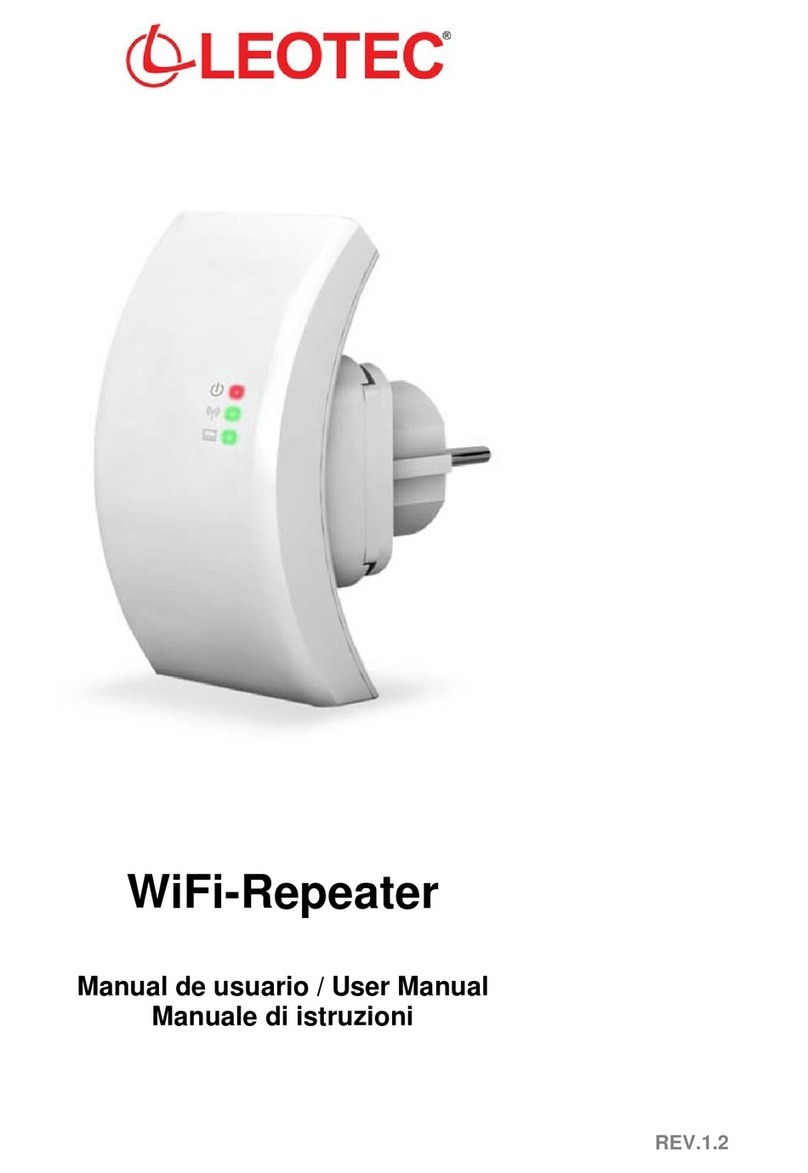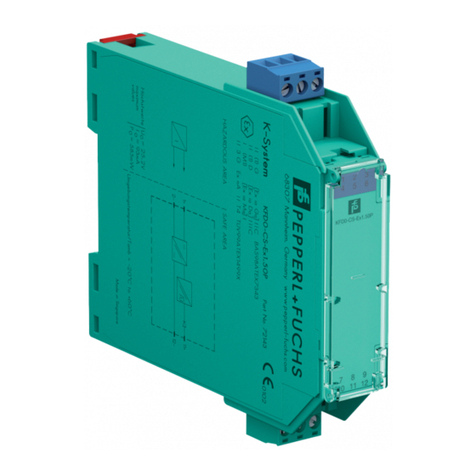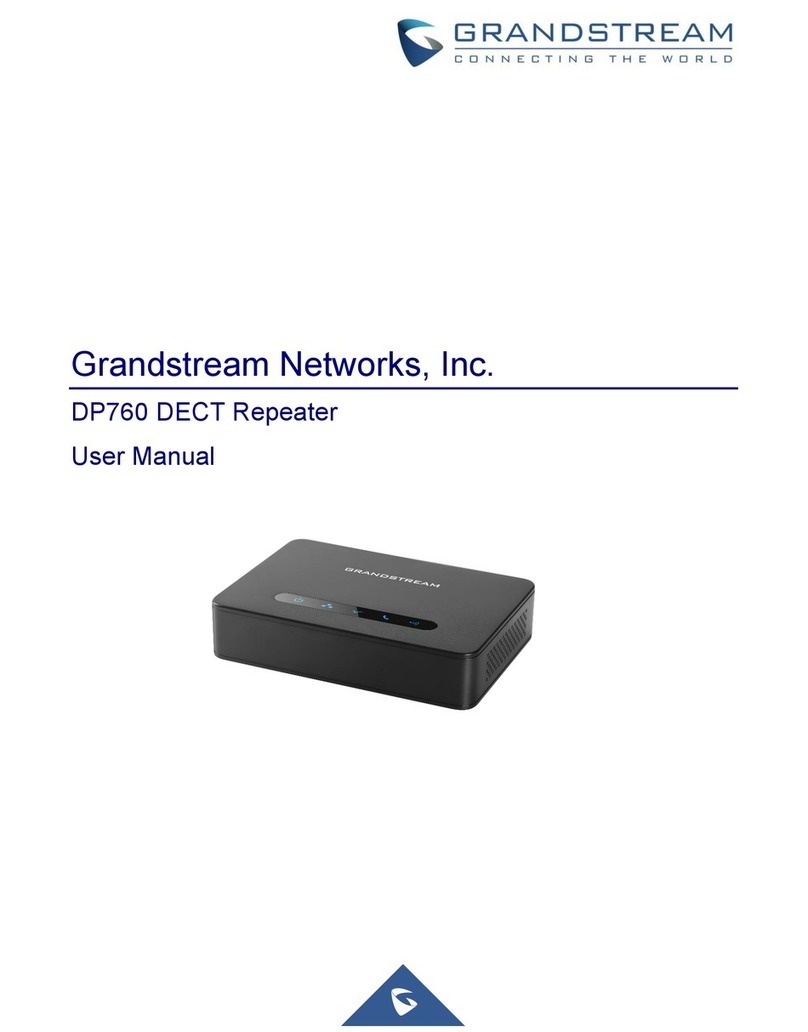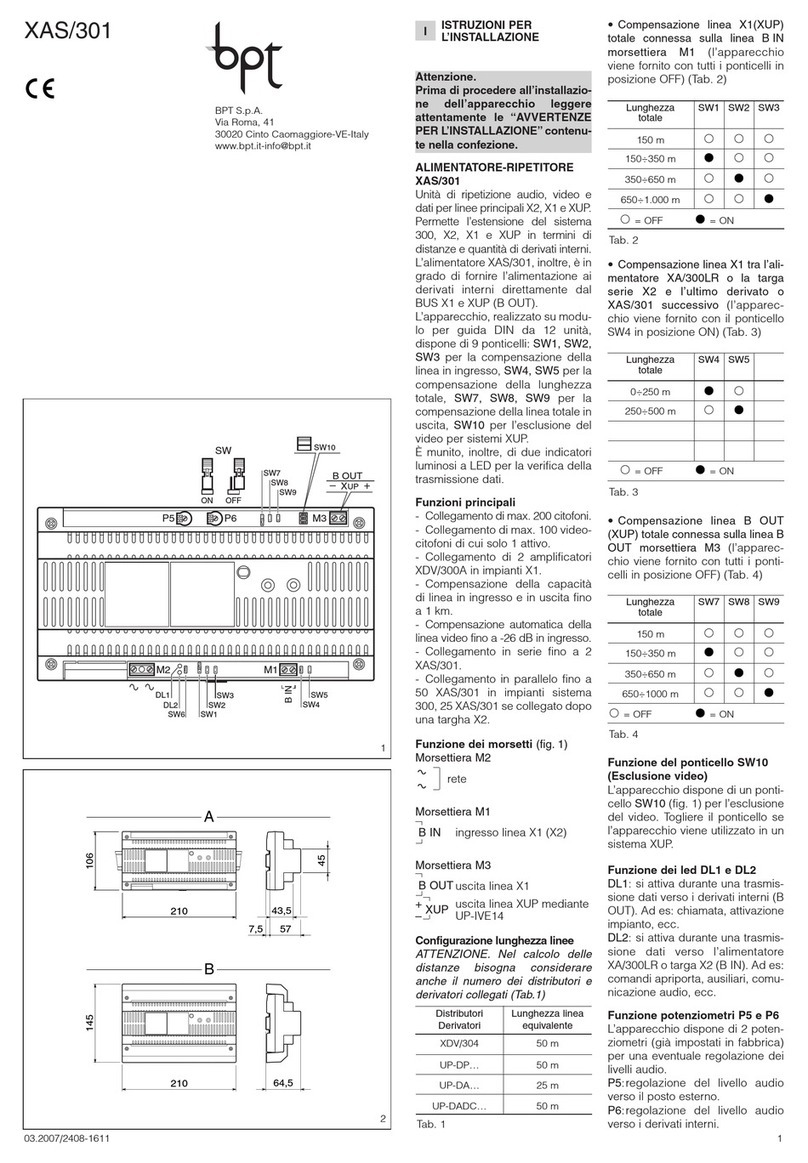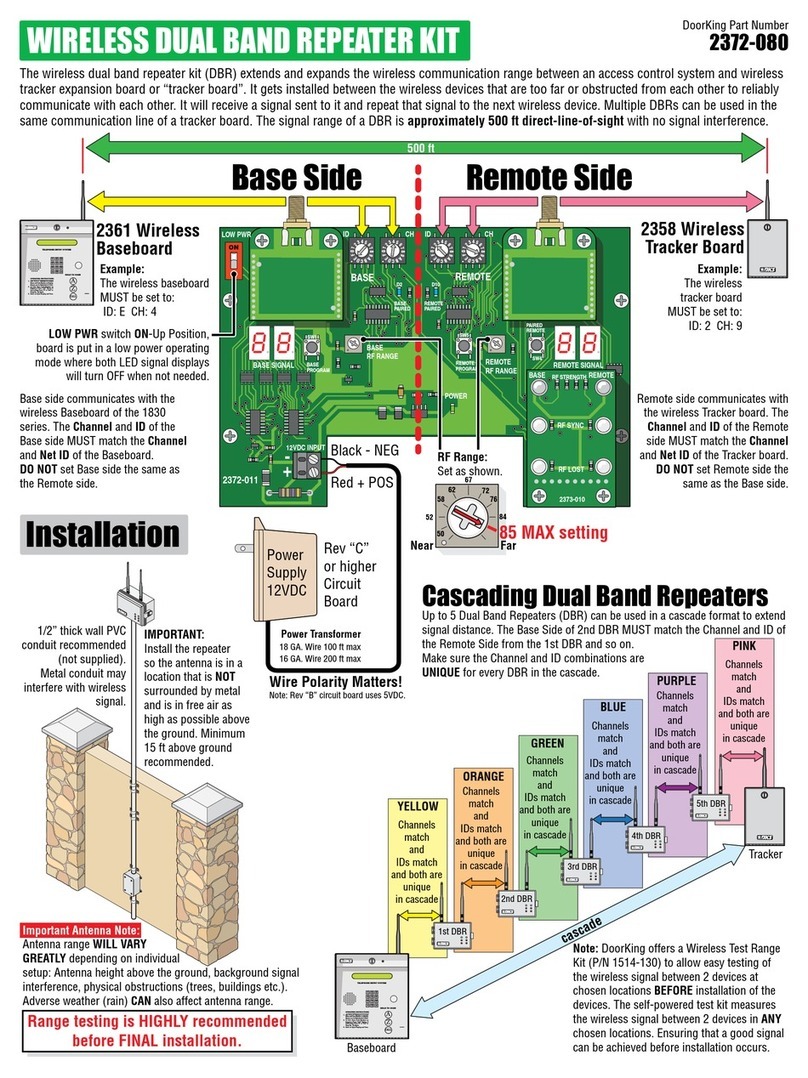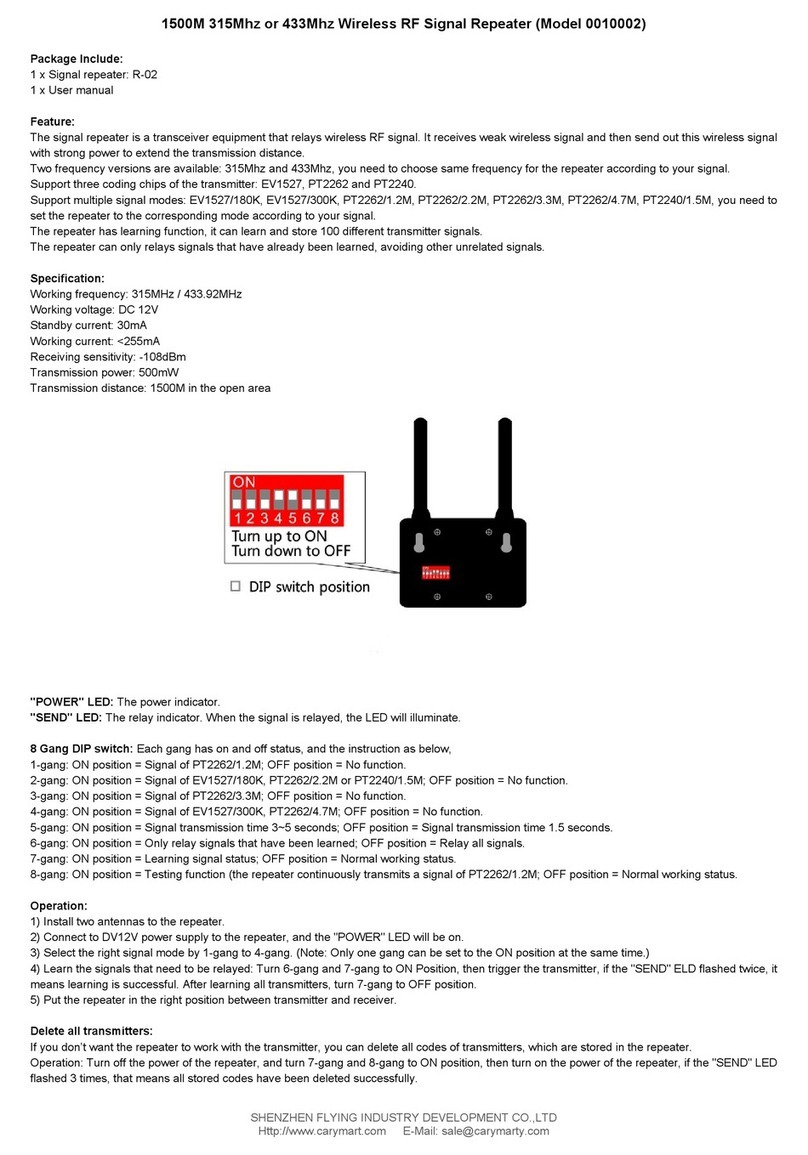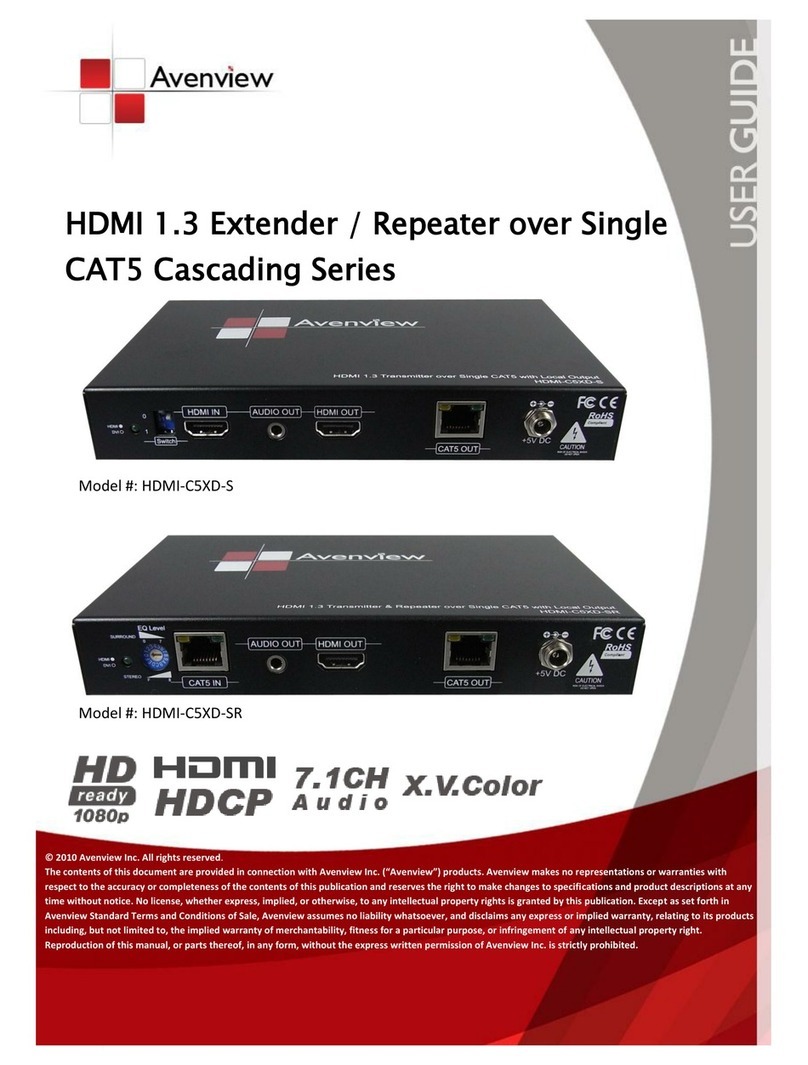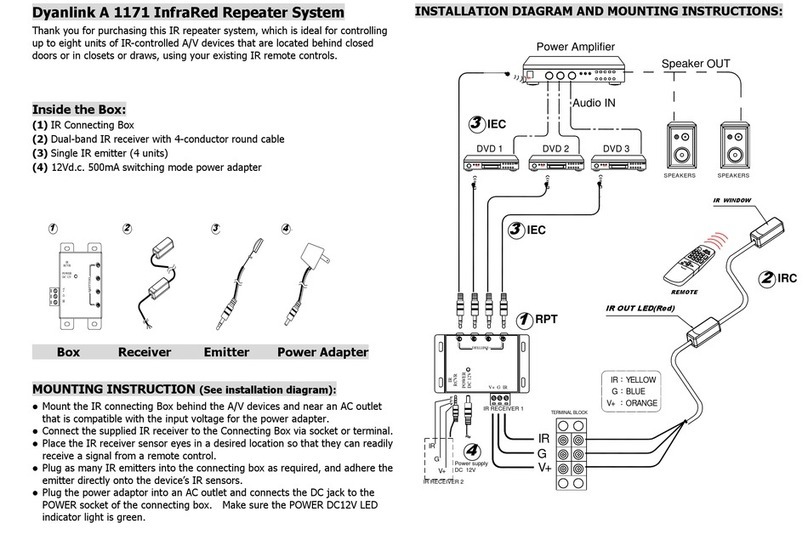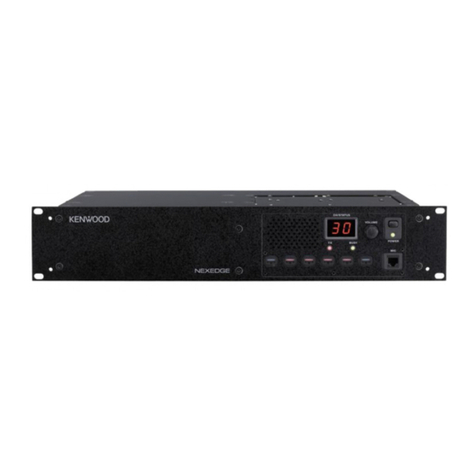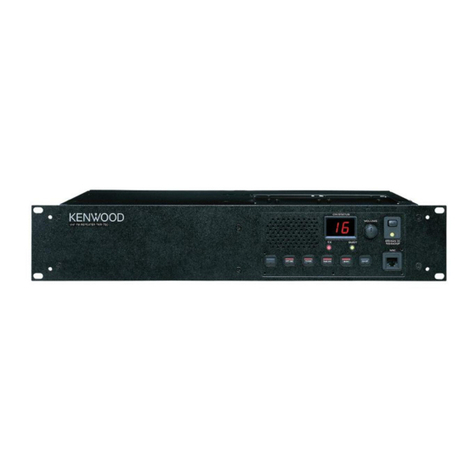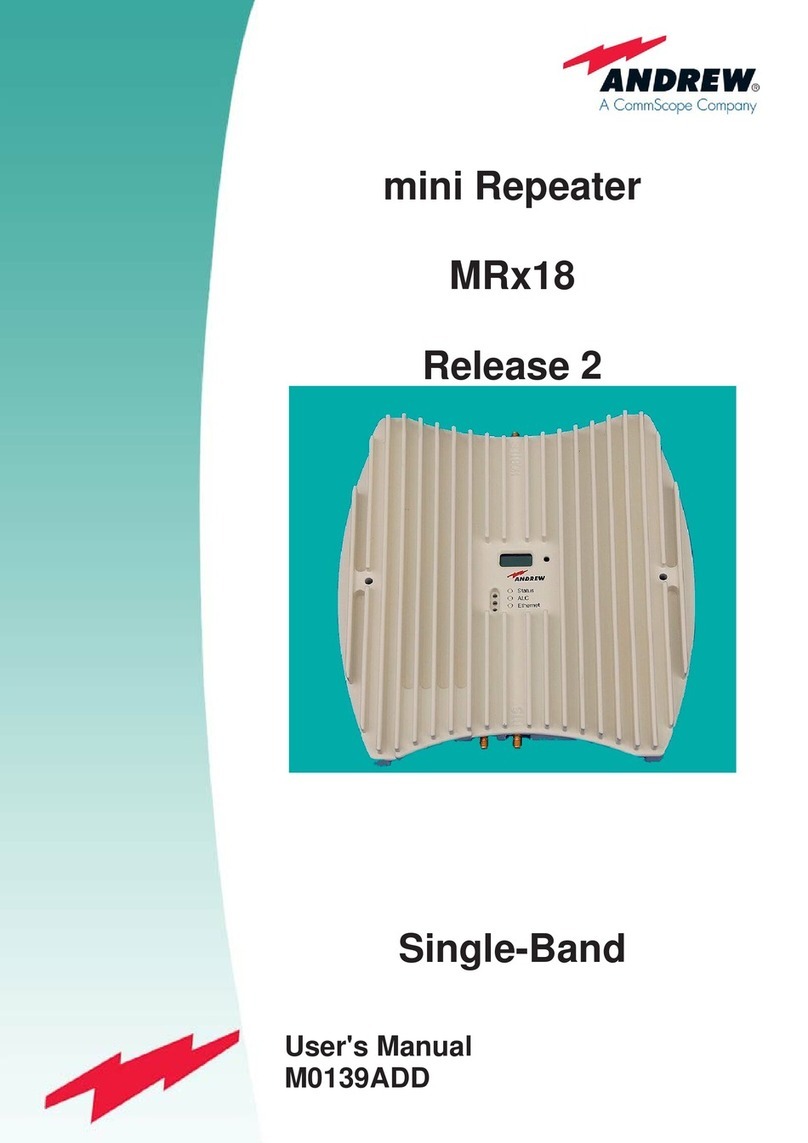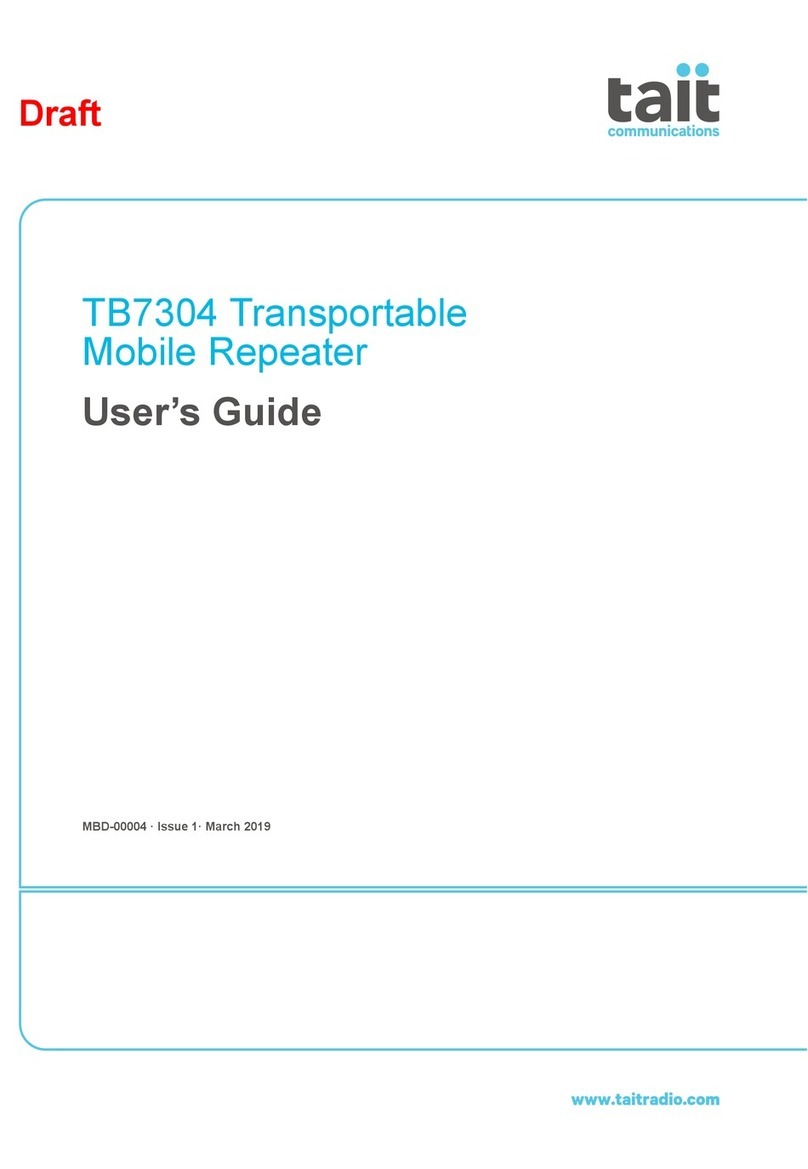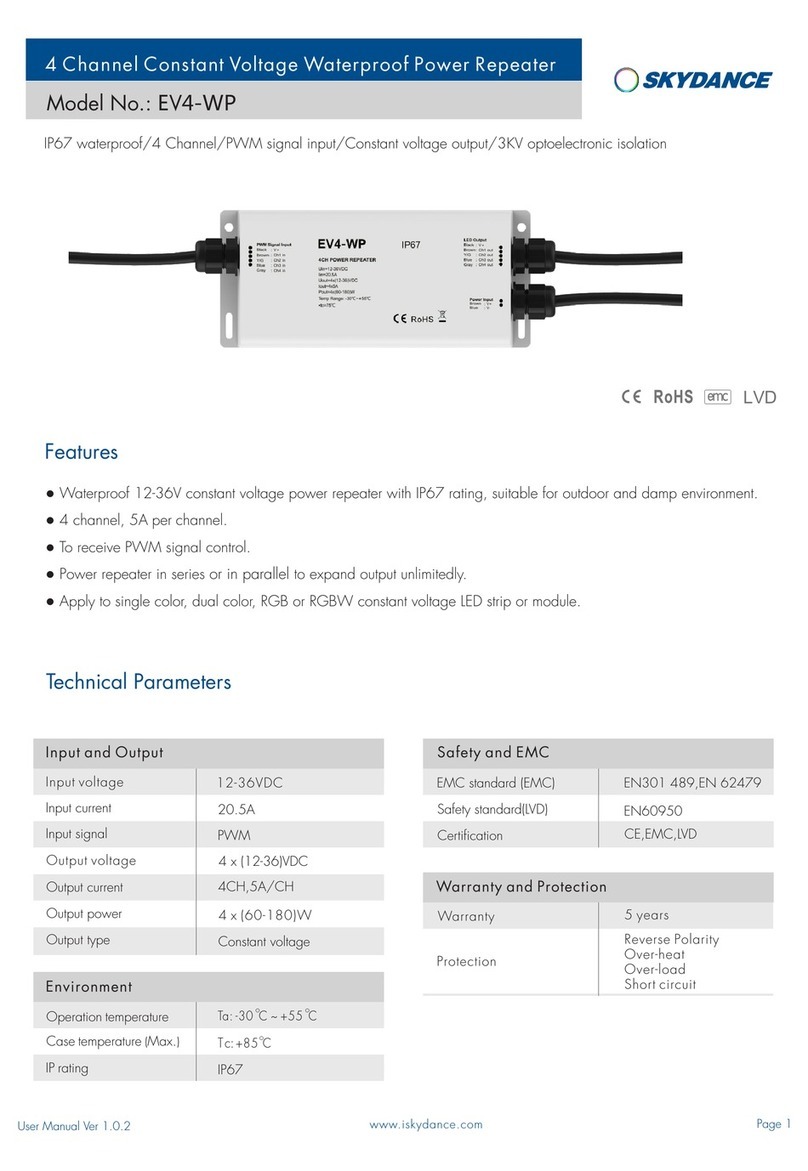Signal Link JD60-7-TB-US User manual

JD60-7-TB-US
Wireless Cellular Repeater
User’s Manual

Wireless Cellular Repeater User Manual
- 2 -
1. SAFETY WARNINGS .....................................................................................................................................................3
2. WHY REPEATER............................................................................................................................................................4
2.1. REASON 1 .................................................................................................................................................................4
2.2. REASON 2 .................................................................................................................................................................4
3. INTRODUCTION.............................................................................................................................................................6
4. SYSTEM CHARACTERISTICS......................................................................................................................................7
4.1. FEATURES:..............................................................................................................................................................7
4.2. APPEARANCE OF THE TRIPLE BAND REPEATERS ...........................................................................................................7
5. BLOCK DIAGRAM AND WORK PRINCIPLE................................................................................................................8
6. THE REPEATER SYSTEM.............................................................................................................................................9
7. THE TRIPLE BAND REPEATER MAIN TECHNICAL SPECIFICATION.....................................................................10
7.1. MECHANICAL SPECIFICATION.....................................................................................................................................10
7.2. ENVIRONMENT CONDITIONS......................................................................................................................................10
7.3. RF TECHNICAL SPECIFICATION .................................................................................................................................. 11
7.4. REQUIREMENTS FOR ADAPTERS:............................................................................................................................12
7.5. REPEATER MODEL LIST ............................................................................................................................................13
8. INSTALLATION.............................................................................................................................................................14
8.1. INSTALLATION LOCATION REQUIREMENT ....................................................................................................................14
8.2. POWER REQUIREMENT .............................................................................................................................................14
8.3. INSTALLATION TOOLS AND ACCESSORY.......................................................................................................................14
8.4. INSTALLATION OF DONOR ANTENNA............................................................................................................................14
8.5. INDOOR ANTENNA INSTALLATION ....................................................................................................................................18
8.6 REPEATER INSTALLATION ...............................................................................................................................................19
8.4.1. Installation Steps............................................................................................................................................19
8.4.2. Repeater’s ports description ..........................................................................................................................21
8.4.3. Accessories selection.....................................................................................................................................21
8.5. REPEATER SETTINGS ...............................................................................................................................................22
8.5.1. Switch on power.............................................................................................................................................22
8.5.2. Manual Gain Control (MGC) ..........................................................................................................................23
8.5.3. GSM & DCS Band Settings............................................................................................................................24
8.5.4. WCDMA Band Settings..................................................................................................................................25
8.5.5. Adjusting System Isolation.............................................................................................................................27
8.5.6. Detecting Repeater........................................................................................................................................28
8.6. SYSTEM TEST ..........................................................................................................................................................28
8.6.1. Check whether the coverage is good.............................................................................................................28
8.6.2. Repeater can not communicate in Power-ON status.....................................................................................29
9. HOT LINE.........................................................................................................................................错误!未定义书签。

Wireless Cellular Repeater User Manual
- 3 -
Preface
This user’s manual describes the installation, commissioning and maintenance of
JD60-7-TB-US Wireless Cellular Repeater.
Please do read the user manual carefully before installing and maintaining the triple band
repeater.
The information in this manual is subject to change without prior notice
Opinions are welcomed about the manual improvement.
1. Safety Warnings
Users must follow the below principles:
zRepeater should follow system requirement of communication equipment, assure good
groundings and lightning protection.
zThe power supply voltage of repeater should meet the standards of security requirement; any
operation shall be carried out only after cutting off power in advance. Only the professional is
authorized for the operation.
zDo not dismantle machine, maintain or displace accessories by yourself, because in
this way, the equipment may be damaged or even get an electric shock.
zDo not open the repeater; touch the module of repeater, or to open the cover of
module to touch the electronic component, the components will be damaged due to
electrostatic.
zPlease keep away from heating-equipment, because the repeater will dissipate heat during
operation. And do not cover repeater with anything that influences heat-dissipation.

Wireless Cellular Repeater User Manual
- 4 -
2. Why repeater
2.1. Reason 1
1) Blind or weak signal areas are formed if the buildings are too far away from BTS, or the buildings
themselves shield or absorb the signals.
2) There are too many complicated signals in the higher part of the buildings, therefore ping-pong switching
effect has been formed and the signals fluctuate a lot, there are annoying noises during phone calls and
there are dropped phone calls accordingly.
3) Elevators and basements are well-known blind areas.
4) Downtown areas of the cities, congested with many high-rise buildings are usually the weak or blind
areas.
2.2. Reason 2
The remote villages, mountains, hills, valleys, etc. are mostly scarcely populated areas with quite few mobile
users, so the main target is to send coverage to these areas, and it will not be cost effect to install a BTS tower,
therefore a repeater is a quite good option.
Can we not use mobile phones? The answer is definitely NO. But it might be much more miserable that the
communication can’t be achieved due to no or weak signals though there is a mobile phone.
Will your customers stay comfortable when there is no smooth communication in your shops or restaurants?
Will your business be influenced if your clients couldn’t call you through due to weak signals in offices?
Will your life be influenced if your mobile is always “out of service” at home when your friends call you?
How to solve the problems?
Best Solution:
Plug & play: Purchase a set of repeater solution and install it at your home, offices, and plug on the
power and immediately you would be able to enjoy the full bar and high quality signals!

Wireless Cellular Repeater User Manual
- 5 -
Question: Will repeater increase the RF radiation?
A: No, it will decrease instead.
As it can be searched easily through internet, the tower would “order” the mobile phone to increase its output
power, in order to ensure successful connection when the mobile signal bar is few, there will be stronger mobile
output power level when the mobile signal bar is less and the strongest one can reach 2W (GSM); moreover,
the mobile phone is usually as near as less than 5cm to human body when people are in phone calls. Not only
it influences badly the human bodies, but also run out of the battery power much more quickly; usually the
mobile phone gets hot in such status.
The maximum power level of JD60-7-TB-US is 0.01~0.1W, and it decreases to be maximum 0.003W when
reaching server antenna. And since the server antenna is installed over the ceiling or onto the wall, there are
usually more than 3 meter away from the human body, 3meter away means at least 40dB propagation loss, or
10000 times less, 0.0000003W, therefore it is too weak to influence human bodies though it is still a very good
signal for mobile phones.
And when a repeater is installed, it improves the mobile signals in the coverage, and the successful phone call
can be connected easily with a much less power level of the mobile phone, thus it will reduce tremendously the
RF radiation.

Wireless Cellular Repeater User Manual
- 6 -
3. Introduction
This JD60-7-TB-US full duplex mobile communications repeater from JDTECK INC is the perfect solution for
providing a wireless improvement in the cellular reception of a home, office, restaurant, VIP Room, apartment,
building or shopping mall, in the quickest time possible. One repeater covers 300 to 600 square meters.
It is designed to improve the call quality of an area by receiving, amplifying and re-transmitting signals of the
base station into a specified area via the server antenna of the repeater.
This repeater has Manual Gain Control (MGC) feature that enables engineers to reduce the gain of the repeater
manually if oscillation is detected or too strong input power level during installation, this will help to get the best
coverage effect without any interference back to mobile network.
And to maintain safe and specific output signal levels during the repeater’s operation, this repeater has a built-in
signal oscillation detection circuit to adjust the gain automatically so as to avoid interference to the cellular
network, also it gets color changing LED’s indicate its environmental status: the Alarm LED’s located on the front
of the unit (Alarm Low & Alarm High) will change color from green to orange or red, (depending on the input
power level) if the system detects signal oscillation in either band or, if the input signal is beyond a safe limit.
Below diagram shows how simple and fast repeater system is installed and works effectively: one wide band
directional antenna, as a donor antenna, has been installed at the top of the roof to pick up good mobile signals
from outside, and send through a 5D-FB cable to a JD60-7-TB-US repeater to be amplified significantly, then the
output signals are divided into three signals by a 8dB coupler and a 2way splitter, sent to three indoor omni
antennas and finally transmitted into the coverage area. Very clear phone call or high speed mobile data services
are immediately effected within the area.

Wireless Cellular Repeater User Manual
- 7 -
4. System Characteristics
4.1. Features:
zCE Certified
zStreamline shape
zExcellent out of band rejection.
zWide power supply range and low power consumption
zHigh-integration (One board to contain low-noise amplifier, band pass filter, power amplifier module,
both uplink and downlink one for all)
zWide band repeater to support all signals within three systems.
zManual gain control provides a variety of applications.
zMTBF>50000h, low failure rate
4.2. Appearance of the triple band repeaters
Figure 1 shows the front view (colors may differ from real products).
Figure 2 Front view of repeater

Wireless Cellular Repeater User Manual
- 8 -
5. Block diagram and work principle
The triple band repeater is a bi-directional repeater that consists of three mobile systems, the three systems
are combined together by a combiner, and each system gets their independent uplink and downlink power
amplifying system, and each link consists of duplexer, LNA, Filter and PA. The triple band repeater downlink
receives, amplifiers and retransmits the signals over the air from BTS to the coverage area; at the same time,
the uplink receives, amplifies and retransmits the signals of MS back to BRS, therefore a successful
communication is accomplished.
Modules in the system diagram:
zCombiner: a combiner helps to combine signals of three mobile systems together, and at the same
time to keep independence of each system and avoid their interference of each other.
zDuplexer: The main purpose of duplexer is to combine downlink and uplink to share the same
antennas, the duplexer is composted of one pair of band pass filter that can not only reject the
spurious interference, but also increase the isolation of Uplink and Downlink
zLNA: LNA is the first active sub system of the repeater, of which low noise and high linearity is
requested under strong input signals. LNA is the major sub system that determines the noise figure
of the repeater system.
zPA: The power amplifier sub system helps the repeater to reach its targeted output power, linearity
of which decides the linearity of the repeater
zPower supply is to supply power electricity to all repeater’s modules

Wireless Cellular Repeater User Manual
- 9 -
6. The repeater system
zDonor Antenna:
¾5~7dbi outdoor panel or 7~9dBi wide band Yagi are recommended as donor antenna.
¾Function: Pick up donor signals from the BTS and send to the repeater by cable; the received
signals’ power level and quality influence a lot on the coverage effect. Donor antenna also
transmit the uplink signals from the repeater to BTS.
zServer Antenna:
¾2~3dBi indoor omni ceiling or 5~7dBi indoor panel are recommended.
¾Omni antenna (Indoor ceiling omni antenna or whip antenna), suitable to installed in the center
and radiate all direction; It is better to use a directional panel antenna or Yagi when the coverage
shape is long and narrow (corridors, long row of houses in two sides, tunnels or elevators or rural
open space)
zCables: LMR 300 or 400, 5D or 8D –FB coax cables are recommended.
zSplitters or couplers: when the building structure is too complicated or there is big loss due to thick
walls, etc., splitters or couplers shall be used so that more antennas can be installed in more areas
to distribute the signals to each corner of the coverage area.
zPower Box including electricity meter, air switch and groundings, some sites might need surge
arrestors.
zNote: because this triple band repeater is a broadband repeater, so band in requirements contain
antenna, splitter and coupler in this system is 880-960MHz and 1710-2170MHz.
zThis device complies with part 15 of the FCC Rules. Operation is subject to the following two
conditions: (1) This device may not cause harmful interference, and (2) this device must accept any
interference received, including interference that may cause undesired operation.

Wireless Cellular Repeater User Manual
- 10 -
zChanges or modifications not expressly approved by the party responsible for compliance could void
the user's authority to operate the equipment.
zThis equipment complies with FCC radiation exposure limits set forth for uncontrolled
environment .This equipment should be installed and operated with minimum distance 400cm
between the radiator& your body.
7. The triple band repeater Main technical specification
7.1. Mechanical specification
SN Item specification
1 Dimensions 250x 330 x 53 mm
2 Weight 4.5kg
3 Environment Conditions IP40
4 Cooling mode Nature cooling
7.2. Environment Conditions
SN Item specification
1 Operating Temperature -25°C to +55°C
2 Storage Temperature -40°C to +80°C
3 Humidity 5% to 85%
4 Air Pressure 86 kPa to 106 kPa

Wireless Cellular Repeater User Manual
- 11 -
7.3.RF technical specification
NO:
Uplink
Test Project Test Condition Index Require
824~849MHz(GSM/CDMA)
1850~1910MHz(PCS/CDMA)
Frequency Range
1710~1755MHz(AWS)
Band Width GSM/CDMA:25MHz, PCS/CDMA:60MHz, AWS:
45MHz
Max .Gain Testing in working band(without control) 63±1dB
ALC Output Center frequency(deep control 10dB)10±10dBm
ALC Center frequency(deep control 1~20dB) |△|≤2.0dB
AGC Center frequency, deep control 15~20dB(red) Shut off
CDMA ≤8dB
GSM/PCS ≤10dB
Gain Flatness Testing in working
band
AWS ≤6dB
1~10dB,1dB step |△|≤1.0dB
11~20dB,1dB step |△|≤1.5dB
Gain control error Center frequency
21~30dB,1dB step |△|≤2.0dB
9KHz~1GHz ≤-36dBm
Intermodulation
Center frequency, double
audio signal interval 600KHz
(deep control 10dB)1GHz~12.75GHz ≤-30dBm
9KHz~1GHz ≤-36dBm
Spurious Emission
Output
inter-modulation 1GHz~12.75GHz ≤-30dBm
Input V.S.W.R Testing in working band ≤3.0
Output V.S.W.R Testing in working band ≤3.0
Group Delay Testing in working band ≤0.5us
Noise Figure Testing in working band(Max gain) ≤8dB
Downlink
Test Project Test Condition Index Require
869~894MHz(GSM/CDMA)
1930~1990MHz(PCS/CDMA)
Frequency Range
2110~2155MHz(AWS)

Wireless Cellular Repeater User Manual
- 12 -
Band Width GSM/CDMA:25MHz, PCS/CDMA:60MHz, AWS:
45MHz
Max .Gain Testing in working band(without control) 67±1dB
ALC Output Center frequency(deep control 10dB)15±10dBm
ALC Center frequency, deep control 1~20dB |△|≤2.0dB
ALC deep control 1~5dB Orange
AGC
Center frequency
deep control 15~20dB red and shut off
CDMA ≤8dB
GSM/PCS ≤10dB
Gain Flatness Testing in working
band
AWS ≤6dB
1~10dB,1dB step |△|≤1.0dB
11~20dB,1dB step |△|≤1.5dB
Gain control error Center frequency
21~30dB,1dB step |△|≤2.0dB
9KHz~1GHz ≤-36dBm
Intermodulation
Center frequency, double
audio signal interval 600KHz
(deep control 10dB)1GHz~12.75GHz ≤-30dBm
9KHz~1GHz ≤-36dBm
Spurious Emission
Output
inter-modulation 1GHz~12.75GHz ≤-30dBm
Input V.S.W.R Testing in working band ≤3.0
Output V.S.W.R Testing in working band ≤3.0
Group Delay Testing in working band ≤0.5us
Noise Figure Testing in working band(Max gain) ≤8dB
Remark:
1,Power supply 12V/5A
2,Shut off function, about 5 second
7.4. Requirements for adapters:
SN Item Minimum Typical value Maximum
1 Input Voltage Range 100 V 220 V 264 V
2 Output Voltage Range 47 Hz 50Hz 63 Hz
3 Total Power Consumption 50W

Wireless Cellular Repeater User Manual
- 13 -
7.5. Repeater Model List
MODEL NO:JD60-7-TB-US -GDW
Device Type F: Wide band consumer repeater
Power rating
10: downlink output power is 10dBm
15: downlink output power is 15dBm
20: downlink output power is 20dBm
C: GSM850 or CDMA800
P: PCS or CDMA1900
A: WCDMA1710-2155
CP: dual band C (GSM850 or CDMA800) & P (PCS or CDMA1900)
System code
CPA: Triple band C (GSM850 or CDMA800) & P(PCS or CDMA1900) &
A (WCDMA1710-2155)
Device Type
Power rating
System code

Wireless Cellular Repeater User Manual
- 14 -
8. Installation
The triple band repeater micro repeater should be used to cover the area indoor and the humidity and
temperature of working can affect the reliability of repeater. So, temperature, humidity, dust, interference, power,
space requirements and other factors should be considered during installation of repeater.
8.4. Installation Location Requirement
1) It is appreciated that the repeater is installed in a cool, dry and ventilated room without erosive gas and
smoke and without leakage on its proof.
2) Besides above, a cool and ventilated wall of which sun-proof and waterproof is expected.
3) Besides above, common wall, tower or high pole is ok.
4) Installation height should be easy for RF cable wiring, heat dissipation, security and maintenance.
5) Have a set of independent and stable power supply.
6) Have lightning conducer in the building, tower or high pole with enough strength or stability.
8.5. Power requirement
Generally it is AC power supply,and the requirement of AC is 100~264VAC/50±5Hz
8.6. Installation tools and accessory
No. Name Specification Quantity Remark
1 Plastic Expansion Bolt M5*24 6 Standard accessories
2 Tapping screw M3*27 4
Standard accessories
3 reciprocating drill 1
Engineering-owned, punch the
wall
4 Shot bit M3 1 Engineering-owned, punch the
wall
8.7. Installation of donor antenna
The repeater’s main function is to improve weak RF signals to an area. A simple formula: Input power+ Gain=
Output power. The signal strength from the outdoor antenna directly affects the efficiency of the indoor coverage.
It is very important to choose the location of the outdoor antenna carefully. With this in mind, it is not

Wireless Cellular Repeater User Manual
- 15 -
recommended the donor antenna to be installed in an attic.
Testing the signal strength received from donor antenna mounted in site by mobile phone:
zPlease select the top of the building to install the donor antenna if the total floors are less than 7,
and must select a place like balcony or platform lower than 7th floor for the donor antenna if the
buildings are over 7 floors.
zThe mobile phone shall display full bar signals in location where the donor antenna is installed
zThe phone calls or data transmission are smooth and stable by 3 times testing in location where
the donor antenna is to be installed
zAs shown from the above illustration, testing the signals from A to E, and select a best place that
displays full bar signals to install the donor antenna.
Selection the installation direction of donor antenna
zThe donor antenna shall point to the direction of the tower, and it would be much better to keep
line of sight.
zPlease select the opposite directions for donor antenna and server antenna. If donor and server
antennas have to be installed in the same direction, please install them only after the signal
quality is tested and the self-oscillation is avoided. If the directional antenna is selected, the
main directional angle should point to the tower antenna.
zIf the performance is poor due to weak signals or poor phone call quality after installation, please
adjust the direction of donor antenna or change its installation position in order to obtain the best
calling effect.
Donor antenna installation ---Notes:
zDo not install the donor antenna during the rainy day with lightning.
zPlease follow the instructions to install the donor antenna.
zIt is a must that the waterproof shall be done to connectors of donor antenna and feeder lines.
zIn order to avoid interference, please note that the donor antenna should be far away from the

Wireless Cellular Repeater User Manual
- 16 -
following objects.
Metal
High-voltage line
RF antenna
High-voltage transformer
zRepeater is a two-way signal amplifier. So proper isolation between donor antenna and server
antenna is necessary in order to avoid self-oscillation. About the definition for self-oscillation,
take MIC and loudspeaker for example; if it is too close for each other, it could make big noise.
So the repeater can run smoothly if the isolation between donor antenna and server antenna is
15 dB higher than the gain of booster. For example, if the booster gain is 60 dB, then the
isolation between donor antenna and server antenna should be 75 decibel.
The minimum distance between donor antenna and server antenna is 10 meters, again the
direction of donor and server antennas shall be opposite.
As shown in the below illustration, the booster amplifies the signal R and signal T from the tower
at the same time. If the distance between donor antenna and server antenna is less than the
required distance, then the amplified signal R (T) will back to server antenna (donor antenna). So
it will lead to self-oscillation and reduce the coverage area, also the bad calling quality could
happen at the same time.
If isolation can’t be achieved by the limited distance, the roof of the building or other barriers can
be used to increase isolation.

Wireless Cellular Repeater User Manual
- 17 -
Installation of panel antenna as donor antenna
Installation of wide directional antenna as donor antenna
Installation of YAGI antenna as donor antenna

Wireless Cellular Repeater User Manual
- 18 -
Test the call quality of donor antenna
Fix the donor antenna after selecting the best position, and adjust slightly its height or angles in
order to get the signals with suitable input power level and calling Quality
zSystem Requirement of GSM or DCS
1) The total input power level shall be around -50dBm, lowest shall be more than –80dBm
2) Test by mobile phone or data card by 3~5 times to make sure the calling quality is good
in 95% of the time, and no handovers.
3) It is requested that the leading BCCH shall be 6dBi higher than the second (for
professional engineering reference only).
zSystem Requirement of WCDMA
1) The total input power level shall be around -50dBm, lowest shall be more than –70dBm
2) Test by mobile phone or data card by 3~5 times to make sure Ec/Io is more than –7dB,
and no handovers.
3) Ec/Io of adjacent carrier shall be 8dB less than that of donor carrier to avoid soft
handover. The active PN shall be only 1.
8.5. Indoor antenna installation
Proper antennas shall be selected according to the site conditions and the requirement.
Omni antenna (Indoor ceiling omni antenna or whip antenna), suitable to installed in the center and radiate all
directions
Lightening
Test Engineer Phone

Wireless Cellular Repeater User Manual
- 19 -
It is better to use a directional panel antenna or Yagi when the coverage shape is long and narrow (corridors,
long row of houses in two sides, tunnels or elevators or rural open space)
8.6 Repeater Installation
8.7.1. Installation Steps
The triple band repeater shall be installed in indoor areas only
Drill holes on the selected place and install expansion bolts.
Align the holes on the installing support with the expansion bolts, keep the installing support vertical, place
flat washers, spring washers, and nuts in turn, and tighten the nuts to fasten the installing support.
Place the repeater on the support and fasten it.
Connect cables and power cables to the repeater respectively.

Wireless Cellular Repeater User Manual
- 20 -
After installing the repeater as described as above, power on the repeater to check the operation status.
Table of contents

